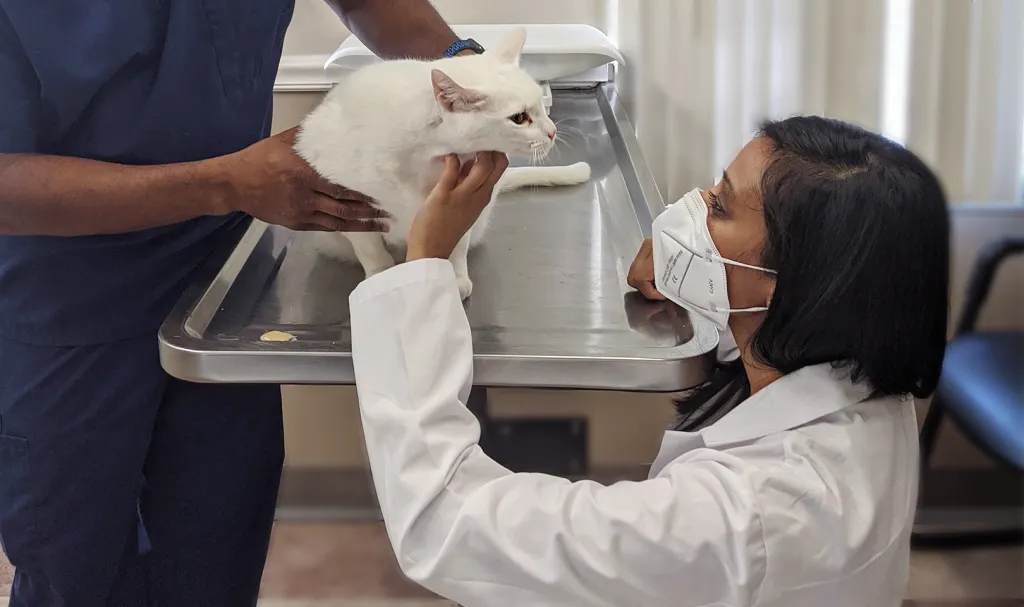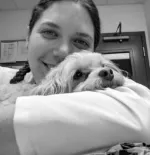Treating feline osteoarthritis with Dr. Kelly


Today I want to talk about feline osteoarthritis. Feline osteoarthritis continues to be the leading cause of pain in cats. In fact more than 90% of senior cats have osteoarthritis in at least one joint.
There is a lot more known about osteoarthritis in dogs. Cats are tough, they don’t want to tell us what’s wrong. In fact, only 50% of cats exhibit clinical signs of joint pain. A big obstacle preventing diagnosis and treatment is feline behavior, but that’s a whole other can of worms.
It is important to pay attention to the subtle changes, and ask questions! Is the patient ever unwilling to jump, or maybe they just can’t jump as high? Maybe the owner has noticed that they are less active around the house, or have a stiff gait when getting up. Maybe they’re going outside the litter box or spending more time alone.
Have you had that client tell you, “don’t scratch his butt he hates that!” Is that new or has he always been like that? The most commonly affected areas are the hips, stifles and hock and elbow. Just imagine having a ton of osteoarthritis in your hips and your person digs in with their fingers…. I’d hate that too.
Treating osteoarthritis
So, what can we do? PAIN MANAGEMENT! Treating pain is key, and can be done with a multimodal approach including drugs, acupuncture, and laser therapy.
Laser therapy is often more effective when the area is shaved, allowing for better penetration, and reducing the risk of the hair absorbing the laser. Fluffy may be walking around with a funny haircut, but at least she’ll be walking!
Cats, as we know can be hard to impossible to pill at home. That’s were compounding pharmacies come into play. A lot of these medications can be compounded into a teat which can be a great option, especially for the food motivated cat.
I know a lot of us are hesitant to use NSAIDs in cats, but they can make a huge difference in quality of life. Meloxicam is a great product, and is often used at a dose of 0.025mg/kg/day. Gabapentin (10mg/kg Q 12hr) can also provide significant pain relief, but can cause significantly decreased activity and lethargy. Tramadol (dosed at 2mg/kg) is not often associated with decreased activity, but is more likely to cause gastrointestinal upset, food aversion, euphoria or worse yet dysphoria.
You may be thinking, what about Onsior? It’s true that Onsior is labeled for use in cats, however, it is only labeled for a maximum of 3 days and does not provide any benefit over meloxicam in long term use.
Adequan can also be used off label and is typically dosed at 2mg/lb SQ twice weekly for 1 month, then weekly for 1 month, then every 10-15 days for long term maintenance.
Addressing osteoarthritis isn’t only about the drugs. Nutraceuticals like glucosamine and chondroitin and omega -3 fatty acids as well as diet can help to support joint function in cats, and is typically well tolerated.
Weight loss and weight management
Managing weight/ weight loss also plays a significant role and is the most important next step! Not only will weight loss decrease the impact on the joints, decreasing pain, but will also help slow progression and development of osteoarthritis.
How can we set our clients and patients up for success on their weight loss journey? The first step is to be as specific as possible. What food should they be eating, how much, what are acceptable snacks and treats, how long should this be taking?
There are many prescription weight loss diets on the market, use them! Unfortunately, there aren’t a lot of mobility diets on the market for our feline patients. Hopefully with time, and as we recognize and address more feline osteoarthritis they will come. Hills already has a Kidney + Mobility feline diet and check out the Mobility diet by Royal Canin (complete with s/o index)!
COVID has made it more challenging to schedule weight checks, but they are key! We need to be sure the patient is losing weight, but also not losing too quickly which could put them at risk for things like hepatic lipidosis. I usually recommend weight checks every 3-4 weeks as well as having the owner keep a weekly log at home.
Explanation is the key to compliance. Many clients don’t realize that the weekly weigh ins at home are the track any sudden or dramatic changes, but the average at home scale will not be sensitive enough to track the more subtle changes our baby scales do and the client may not see any change week to week at home.
Regular weight check-ins in the hospital also provide a great opportunity to reassess pain levels and determine is adjustments need to be made to the patients’ pain management therapy.
Weight loss strategies
Weight loss isn’t just about diet. Using puzzle toys and timed feeders can help slow down eating and keep the pet feeling fuller throughout the day.
The biggest obstacle I have is getting people to measure the food, or even worse, when they are measuring, but have a multi-cat household and leave all the bowls down all day. I just explained to someone yesterday that his pet was continuing to gain weight even though he was measuring because after finishing his food he was eating his other cats food. Now we’re going to try meal feeding in separate rooms.
For the clients without financial concern there are amazing microchip activated feeders. This will let the client leave a pre-portioned mount of food out without letting the other pets dip into each other’s food.
Feline physical therapy
Now let’s talk physical therapy. Our goals are the restore function, improve range of motion and strength and improve the patients’ quality of life.
In order to do this we first need to have adequate pain control. This is not a “feel the burn” kind of situation. Cat’s aren’t great at exercise, and passive range of motion doesn’t provide much benefit to them, so it can be challenging to engage the muscle and keep them moving.
There are many physical therapy options, including use of the water treadmill can be an excellent option for increasing muscle strength as well as weight loss.
At home, play via laser or ribbon toys can be fun additional sources of activity. Remember, motion is lotion!
In conclusion
When treating feline osteoarthritis, remember that the cat can’t tell you what’s wrong. By focusing on pain management, weight management, and physical therapy, your furry patient will be on their way to recovery.
Dr. Kelly Dunham is an area medical director for IndeVets.
More from IndeVets:
A review of heartworm treatment guidelines
